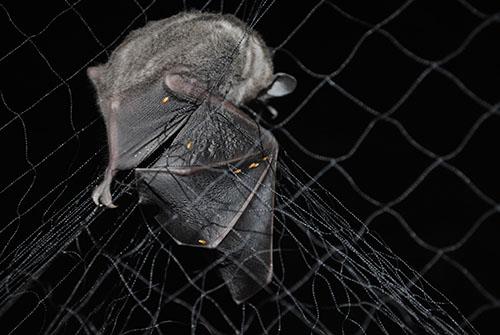Rodrigo de Macêdo Mello
Several studies about mutualistic interactions between bats and plant species revealed the importance of those interactions for ecosystem maintenance. On the other hand, antagonistic interactions between bats and ectoparasites can affect the bat fitness and consequently cause disturbs for the bat populations. However, both mutualistic and antagonistic interactions were not concomitantly studied and we do not known how ectoparasites can affect the plant-bat mutualistic network indeed. Thus, the aim of this work focuses on the dynamics of multitrophic relationships among plants-bats-ectoparasites and how those interactions will influenced by several characteristics of highly fragmented landscapes by human activities.

A bat of the species Carollia perspicillata with several ectoparasites in the wing. ©Rodrigo M Mello.
Mutualistic interactions between bats and plants play relevance functions for maintenance of several ecosystem processes, including seed dispersion. In fact, the fruit consumption by bats is very important because bats are among the main seed dispersion actors of pioneering plant species contributing for the natural recuperation of fragmented forest areas. Bat-plant interactions are affected by several factors such as ectoparasites incidence in bats, which can reduce the individuals’ fitness and influence in the social structure of bat species. Fragmentation processes also play important role at bat-plant interactions due the habitat losses. Studies on ecological interactions mostly include only two trophic levels, as mutualistic interactions between bats and plants, and antagonistic interactions between bats and ectoparasites. However, interactions in fact occur not in a compartmented way, but like a complex network of ecological interactions in several trophic levels. Thus in determining the perturbation in any trophic level or even in one species can cause a great impact in several components of interaction networks. In this way, the complex network methods have increased our knowledge about interactions under several prisms. For example, it permits the observation of particular proprieties possible only by this methods and a better perception about the dynamics of the ecological interactions.

Researcher analyzing a bat of the species Artibeus lituratus. ©Luciana C Pereira.
Bats are very important components in the tropical communities because they present high diversity and play several ecosystem functions. In this context, the dynamics of multitrophic interactions among bats, plants and ectoparasites make the study an adequate model in order to comprise how those interactions are affected by several landscape characteristics human modified. The increased knowledge by the project would help in decisions on conservation strategies in areas that support robust structure of interactions and recuperation of areas with unbalanced ecological interactions.